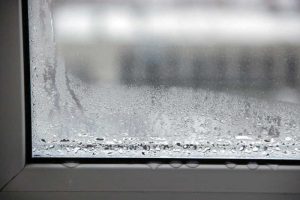
FAILURES
Rich Rinka, FGIA, AAMA
Condensation on windows, doors, and skylights was once considered an inevitable nuisance. Today, it is taken more seriously. Moisture collection can stain or damage walls and building contents, or it can induce mold growth leading to costly remediation.
Condensation does not mean failure of the glass or fenestration product. Rather, it serves as a warning that other conditions need to be addressed.
Condensation Conditions
Condensation forms when the temperature of the object falls below dewpoint—the temperature at which airborne water vapor turns into a liquid. The warmer the air, the more moisture it can hold. As the amount of water vapor in the air (relative humidity [RH]) increases, the dewpoint also increases, and condensation becomes more likely. In cold weather, the temperature of the interior surface of fenestration can fall below the dewpoint, encouraging condensation. If the dewpoint is below 0 C (32 F), it can be in the form of frost or even ice.
Minimizing Condensation

The task of minimizing condensation is twofold: partially requiring proper design to accommodate conditions stemming from the building’s location as well as its occupancy and use, and partially by managing the interior conditions after occupancy. The key is understanding the root source of the condensation to address it.
Designing to Minimize Condensation
Most fenestration product designs use insulating glass with inert gas fill, warm-edge spacers, and low-emissivity glass coatings that are effectively sealed into framing with an effective thermal break, and properly installed with adequate weatherstripping. These combined components typically increase condensation resistance and enhance thermal transmittance (U-factor) for improved energy efficiency.
There are three different condensation rating systems available to compare similar products’ performance. The American Architectural Manufacturers Association (AAMA) Condensation Resistance Factor (CRF), the National Fenestration Rating Council Condensation Rating (CR), and the Canadian Standards Association Temperature Index (I) all use a dimensionless numerical index with higher values indicating better performance.
A single rating system should be used when comparing products, as CRF, CR, and I are derived by different methods, differ significantly, and are not interchangeable. Many manufacturers obtain only one of these ratings for their products.
Condensation Management
The principal task in minimizing condensation is to lower the indoor humidity and/or keep the inside surface temperature of the glass and frame above the dewpoint temperature, especially when outdoor temperatures are frigid.
As the outdoor temperature drops, so should the indoor humidity. When outdoor temperatures are in the -7 to 4 C (20 to 40 F) range, the indoor relative humidity (RH) should not exceed 40 percent. When outdoor temperatures dip to below -29 C (-20 F), indoor humidity should not exceed 15 percent. It may be necessary to run a dehumidifier as part of the HVAC system. Exhaust fans may be needed to remove excess moisture from humidity-generating areas. Curtains and blinds should be opened during winter daylight hours to take advantage of passive solar heating.
Failing to properly design for condensation resistance or to address it when it does occur is typically what causes related problems.




